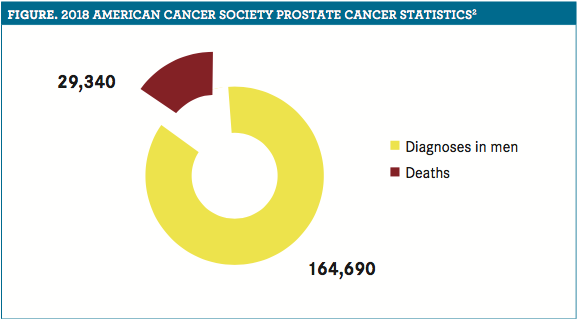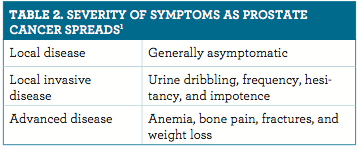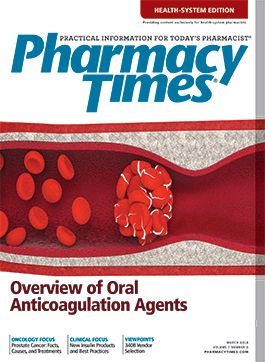Publication
Article
Pharmacy Practice in Focus: Health Systems
Prostate Cancer: Facts, Causes, and Treatments
Prostate cancer is the leading cancer in men, with about 1 in 8 developing it in his lifetime.
Prostate cancer is the leading cancer in men, with about 1 in 8 developing it in his lifetime. In 2017, prostate cancer was the third-leading cause of cancer-related death in men in the United States, behind lung and bronchus and colon and rectal cancers.1 The American Cancer Society (ACS) estimates that in 2018, there will be almost 30,000 deaths related to prostate cancer, with almost 165,000 new diagnoses (figure).2 Prostate cancer is a testosterone-driven cancer that typically presents in men over 40. It is also one of the leading causes of cancer deaths in developed countries throughout the world.3

Despite the numbers above, the overall prostate cancer death rate has been steadily declining by about 3% each year since 1999.1 When the cancer is identified at a local or regional stage, the 5-year relative survival rate is close to 100% (table 1).4
Unique features of prostate cancer include an enlarged prostate and the presence of a bumpy or nodular prostate on a digital rectal exam (DRE) and abnormal elevations in prostate specific antigen (PSA), with complicating risk factors. In addition, elevated alkaline phosphatase may also indicate metastatic disease that has spread to the bone or liver. Urinary symptoms that are involved with prostate cancer may include dribbling, frequency, hesitancy, and nocturia. Early detection of prostate cancer, while the disease is asymptomatic and localized, can be difficult. It is not until further progression that symptoms worsen and become more bothersome (table 2).1

RISK FACTORS
The exact cause of prostate cancer is unknown. However, there are several risk factors that may influence the development of cancer cells among healthy prostate cells (table 3).1,5,6 There are inherited gene mutations that can change DNA sequences, leading to the production of oncogenes.5 Acquired gene mutations are also capable of the production of oncogenes but instead result from exposure to risk factors such as diet and hormone levels.5 Advanced age, however, is one of the biggest risk factors. As the amount of time that cell replication has been occurring increases, the chances of cell mutation also increase. About 60% of prostate cancers are diagnosed in men 65 years and older.5 As with all cancers, exposure to carcinogens in cigarettes, high-fat and overprocessed foods, and obesity are known risk factors.6 One risk factor that defies explanation is being an African American man.7 Many of these risk factors for prostate cancer are modifiable. This makes implementation of lifestyle modifications especially important in the prevention of prostate cancer.

SCREENING AND DIAGNOSIS
Screening for prostate cancer includes the DRE and PSA tests. Based on results from these, additional tests that may be performed for diagnosis are magnetic resonance imaging scans, a prostate biopsy, and/or ultrasounds.8 The ACS’ recommendations for prostate cancer screening vary by age and risk factor (table 4).8 The frequency of subsequent PSA tests is based on the results of the initial screening. Patients with PSA levels below 2.5 ng/mL should be screened every 2 years. However, men with PSA levels above 2.5 ng/mL should be screened annually.9 There has been some debate regarding screening, the main concerns being false positives and overtreatment leading to avoidable adverse effects, such as erectile dysfunction and urinary incontinence, because of further diagnostic testing.7 However, the ACS still recommends early PSA screenings, despite the contentious debate.

TREATMENT
Treatment varies based on each patient’s demographics, progression, and stage of prostate cancer. When the disease is local, patients have 3 main treatment options (table 5).10 ​​​​​​​
Treatment options for advanced disease include multiple modalities, which are explained in table 6,10 androgen deprivation therapy, chemotherapy, and immunotherapy. Androgen deprivation therapy has multiple routes through which it can be administered: androgen synthesis inhibitors, antiandrogen agents, bilateral orchiectomy, and luteinizing hormone-releasing hormone (LHRH) agonist and antagonist agentsAn LHRH agonist desensitizes the prostate by lowering the testosterone levels over a brief period, causing a tumor flare. An LHRH antagonist acts directly on the pituitary gland, where it competitively inhibits the LHRH receptors. The antagonist agents work much quicker than their agonist counterparts and do not induce a tumor flare. Chemotherapy is traditionally reserved for later-stage prostate cancer, after the development of castration-resistant prostate cancer, and generally involves a taxane-based regimen of either cabazitaxel or docetaxel. Common adverse events with taxane-based regimens are edema, nail changes, and peripheral neuropathies. The use of nerve-sparing prostatectomy surgery can improve the patient’s quality of life,11 as the surgical team’s primary goal must be removal of the cancer. This type of surgery reduces the possibility of surgical damage, allowing for normal erections.11 However, depending on the stage and location of the cancer, nerve-sparing surgery may not be possible. Surgical interventions, which may remove the cancer, can have serious complications that affect quality of life, such as urinary incontinence.

Immunotherapy is a new mode of treatment for all cancers. The idea is to manipulate the host immune system to attack and destroy cancer cells as if they were foreign invaders. Sipuleucel-T (Provenge) is the only immunotherapy vaccine that is FDA approved for the treatment of prostate cancer.12 The injection is usually reserved for metastatic prostate cancer and for men who have failed androgen deprivation therapy.12 Because sipuleucel-T is a new therapy, the cost is high, but patient assistance programs are available.13
CONCLUSION ​​​​​​​
Prostate cancer in most patients is a highly treatable malignancy, if detected early. Early intervention may save up to 30,000 lives. Admittedly, the patient selection process needs to be carefully defined to prevent unnecessary treatment. Because this can be a manageable cancer, clinicians should identify high-risk patients early and educate them about their options and treatment choices. If high-risk patients can be encouraged to seek treatment at a very early stage, the number of deaths could decrease significantly. Many risk factors are modifiable. Patients must make responsible choices for their lifestyle.
Jerry A. Barbee Jr, PharmD, BCPS, CPh, and Glenn Schulman, PharmD, MS, BCPS, BCACP, BCGP, are clinical hospital pharmacists in Pensacola, Florida.
Aericka O’Neal-Scott is a PharmD candidate at Florida Agricultural and Mechanical University in Tallahassee.
Justin Powell is a PharmD candidate at Marshall University in Huntington, West Virginia.
References
1. Cancer facts & figures 2017. ACS website. cancer.org/content/dam/cancer-org/ research/cancer-facts-and-statistics/annual-cancer-facts-and-figures/2017/cancer- facts-and-figures-2017.pdf. Accessed January 29, 2018.
2. American Cancer Society. 2018 estimates. Cancer Statistics Center website. cancerstatisticscenter.cancer.org/#!/. Accessed January 29, 2018.
3. Torre LA, Bray F, Siegel RL, Ferlay J, Lortet-Tieulent J, Jemal A. Global cancer statistics, 2012. CA Cancer J Clin. 2015;65(2):87-108. doi: 10.3322/ caac.21262.
4. Siegel RL, Miller KD, Jemal A. Cancer statistics, 2017. CA Cancer J Clin. 2017;67(1):7-30. doi: 10.3322/caac.21387.
5. What causes prostate cancer? ACS website. cancer.org/cancer/prostate-cancer/ causes-risks-prevention/what-causes.html. Updated March 11, 2016. Accessed January 21, 2018.
6. Siegel RL, Jacobs EJ, Newton CC, et al. Deaths due to cigarette smoking for 12 smoking-related cancers in the United States. JAMA Intern Med. 2015;175(9):1574-1576. doi: 10.1001/jamainternmed.2015.2398.
7. Prostate cancer risk factors. Prostate Cancer Foundation website. pcf.org/c/ prostate-cancer-risk-factors/. Accessed January 21, 2018.
8. American Cancer Society recommendations for prostate early cancer detec- tion. ACS website. cancer.org/cancer/prostate-cancer/early-detection/acs- recommendations.html. Updated April 14, 2016. Accessed January 14, 2018.
9. Harvard Medical School. The new PSA report: understand the controversy. health.harvard.edu/mens-health/the-new-psa-report-understand-the-controversy. Published February 2012. Accessed January 16, 2018.
10. Prostate cancer: treatment options. American Society of Clinical Oncology website. cancer.net/cancer-types/prostate-cancer/treatment-options. Accessed January 21, 2018.
11. Prostate cancer. Mayo Clinic website. mayoclinic.org/diseases-conditions/ prostate-cancer/diagnosis-treatment/drc-20353093. Accessed January 14, 2018. 12. Hutchison C. Provenge cancer vaccine: can you put a price on delaying death? ABC News website. abcnews.go.com/Health/ProstateCancerNews/Provenge- cancer-vaccine-months-life-worth-100k/story?id=11269159. Published July 29, 2010. Accessed January 26, 2018.
13. Prostate Cancer Foundation. Immunotherapy: a vaccine for prostate can- cer. PCF website. pcf.org/news/immunotherapy-a-vaccine-for-prostate-cancer/. Published June 15, 2017. Accessed January 22, 2018.

Newsletter
Stay informed on drug updates, treatment guidelines, and pharmacy practice trends—subscribe to Pharmacy Times for weekly clinical insights.





